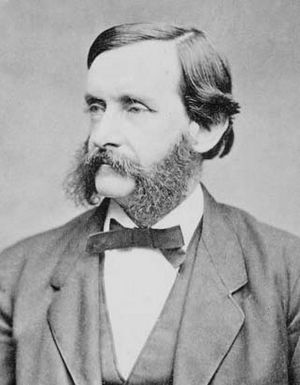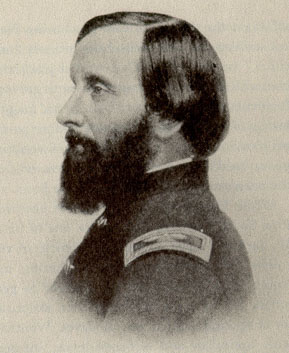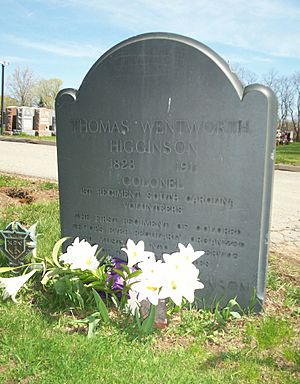Thomas Wentworth Higginson facts for kids
Quick facts for kids
Thomas Wentworth Higginson
|
|
|---|---|
 |
|
| Member of the Massachusetts House of Representatives from the 1st Middlesex district | |
| In office January 7, 1880 – January 4, 1882 Serving with George W. Park (1880) and Henry W. Muzzey (1881)
|
|
| Preceded by | Edwin B. Hale |
| Succeeded by | Chester W. Kingsley |
| Personal details | |
| Born | December 22, 1823 Cambridge, Massachusetts, U.S. |
| Died | May 9, 1911 (aged 87) Cambridge, Massachusetts, U.S. |
| Political party | Free Soil (1850–51) Republican Democratic (1888) |
| Occupation | Minister, author, soldier |
| Signature | |
Thomas Wentworth Higginson (December 22, 1823 – May 9, 1911) was an important American figure. He was a Unitarian minister, a writer, and a soldier. He also fought strongly against slavery and for equal rights.
During the 1840s and 1850s, Higginson was very active in the Abolitionist movement. This movement worked to end slavery in the United States. He believed that slavery should be stopped, even if it meant the country would split apart. He was one of the "Secret Six" who supported John Brown. Brown was an abolitionist who tried to start a slave uprising.
During the Civil War, Higginson led the 1st South Carolina Volunteers. This was the first official U.S. Army regiment made up of African American soldiers. He served with them from 1862 to 1864. After the war, he wrote about his experiences. He spent the rest of his life fighting for the rights of formerly enslaved people and women.
Contents
Early Life and Education
Thomas Wentworth Higginson was born in Cambridge, Massachusetts, on December 22, 1823. His family had a long history in America. He was a descendant of Francis Higginson, an early Puritan minister. His father, Stephen Higginson, was a successful merchant. His grandfather, also named Stephen Higginson, was part of the Continental Congress.
Becoming an Abolitionist
Higginson was very smart and started Harvard College at age thirteen. He graduated in 1841 when he was 18. After teaching for a short time, he decided to study theology at the Harvard Divinity School.
In 1845, he left divinity school to focus on ending slavery. He strongly opposed the Mexican–American War. He believed this war was mainly to expand slavery in new territories. Higginson wrote poems and gathered signatures against the war. He joined a group of abolitionists who thought slavery could only end if slave states left the Union.
Family Life
Higginson later returned to divinity school and became a minister. In 1847, he married Mary Elizabeth Channing. Mary's uncle was William Ellery Channing, a famous Unitarian minister. They did not have their own children but raised Margaret Fuller Channing. Mary died in 1877. Two years later, Higginson married Mary Potter Thacher. They had two daughters, but only one lived to adulthood.
Higginson's Career and Activism
Higginson had a varied career as a minister, politician, and activist. He was always fighting for what he believed was right.
Ministry and Early Activism
After graduating, Higginson became a pastor at a Unitarian church in Newburyport, Massachusetts. He was known for his liberal views. He supported the local Antislavery Society. He also spoke out against the poor working conditions in cotton factories.
Higginson invited famous abolitionists like Theodore Parker and William Wells Brown to speak at his church. He also brought Ralph Waldo Emerson to speak in Newburyport. His strong views were sometimes too radical for his church members. He resigned from his position in 1849. After that, he gave speeches on the Lyceum circuit, sharing his ideas with many people.
Fighting for Abolition and Rights
The Compromise of 1850 made the fight against slavery even more intense. Higginson ran for Congress in 1850 but lost. He urged people to ignore the Fugitive Slave Act of 1850. This law required people to return escaped enslaved people to their owners.
He joined the Boston Vigilance Committee. This group helped protect enslaved people who had escaped to freedom. Higginson helped several people escape to Canada. In 1854, he led a group that stormed a courthouse in Boston. They tried to prevent an escaped man named Anthony Burns from being sent back to slavery. Higginson was injured but wore the scar proudly.
In 1852, Higginson became a pastor in Worcester. There, he continued to support abolition. He also spoke out for temperance (avoiding alcohol), workers' rights, and women's rights.
Higginson became convinced that peaceful methods alone would not end slavery. He supported the idea of the country splitting apart over the issue. He was a strong supporter of John Brown. Higginson was one of the "Secret Six" who helped Brown prepare for his raid at Harper's Ferry, West Virginia. Even though his involvement was known, Higginson was never arrested.
In 1879, Higginson was elected to the Massachusetts House of Representatives. He served for two years. He later ran for the U.S. House of Representatives in 1888 but was not elected.
Advocating for Women's Rights
Higginson was a leading male supporter of women's rights before the Civil War. In 1853, he spoke at a convention in Massachusetts. He supported a petition asking for women to be allowed to vote. His speech, "Woman and Her Wishes," was used for many years to promote women's rights.
He was a close friend of women's rights leader Lucy Stone. He performed her marriage ceremony in 1855. He also helped publish her "Marriage Protest," which became a famous document. This protest spoke out against unfair marriage laws. Higginson also helped create and edit The Woman's Rights Almanac for 1858. This book shared facts about the differences in pay between men and women.
After the Civil War, Higginson continued his work for women's suffrage (the right to vote). He helped start the New England Woman Suffrage Association in 1868. He also helped found the American Woman Suffrage Association. He was an editor for the newspaper Woman's Journal for fourteen years. As a state legislator, he helped connect suffragists with lawmakers.
Civil War Experiences
During the Civil War, Higginson became a captain in the 51st Massachusetts Infantry. Later, he became a colonel. He led the First South Carolina Volunteers. This was the first official Union Army regiment made up of formerly enslaved people. The U.S. Secretary of War required white officers to lead black regiments.
Higginson wrote about his experiences in Army Life in a Black Regiment (1870). He described the bravery and strength of his soldiers. He also helped save Negro spirituals by writing down the songs he heard around the campfires. Historian James M. McPherson noted that Higginson did not share the common racial prejudices of his time.
Religious Views
After the Civil War, Higginson became active in the Free Religious Association (FRA). In 1870, he gave a speech called The Sympathy of Religions. He argued that all religions share important truths. He believed that all faiths encourage kindness and good deeds.
Higginson felt that differences between religions were not as important as their shared values. He said, "Every step in the progress of each brings it nearer to all the rest." He encouraged the FRA to be open to all religious beliefs, even those different from their own. He spoke at the Parliament of the World's Religions in 1893. He praised how much different religions had come to understand each other.
Later Years and Legacy
In his later years, Higginson focused mostly on writing. His books show his love for nature, art, and people. In Common Sense About Women (1881) and Women and Men (1888), he argued for equal opportunities and rights for everyone.
Higginson was elected to the American Antiquarian Society in 1874. He also helped found the Society of American Friends of Russian Freedom in 1891. This group supported freedom in Russia.
Thomas Wentworth Higginson died on May 9, 1911. He is buried in Cambridge Cemetery in Cambridge, Massachusetts.
Relationship with Emily Dickinson
Higginson is well-known for his connection with the famous poet Emily Dickinson. In 1862, Higginson wrote an article giving advice to young writers. Emily Dickinson, who was 32, sent him a letter with four of her poems. She asked, "Are you too busy to say if my Verse is alive?"
Higginson replied and gave her gentle feedback on her unique poems. He also asked about her background and for more poems. However, he advised her not to publish her poetry. He thought her style was too unusual for the time.
Higginson became Dickinson's mentor. He visited her twice at her home in Amherst. He later wrote that he never fully understood her. After Dickinson died, Higginson worked with Mabel Loomis Todd to publish her poetry. They edited her poems to make them more traditional. Higginson's fame helped introduce Dickinson's amazing poetry to the world.
Selected Works
Higginson wrote many books and articles, including:
- Outdoor Papers (1863)
- The Works of Epictetus (1866), a translation of ancient Greek writings
- Army Life in a Black Regiment (1870)
- Atlantic Essays (1871)
- A Book of American Explorers (1877)
- Common Sense About Women (1881)
- Margaret Fuller Ossoli (1884), a biography
- A Larger History of the United States of America (1885)
- The Afternoon Landscape (1889), a collection of poems
- Cheerful Yesterdays (1898), his autobiography
- Old Cambridge (1899)
- Henry Wadsworth Longfellow (1902), a biography
- John Greenleaf Whittier (1902), a biography
Images for kids
See also
 In Spanish: Thomas Wentworth Higginson para niños
In Spanish: Thomas Wentworth Higginson para niños
- Col. Thomas Wentworth Higginson House




